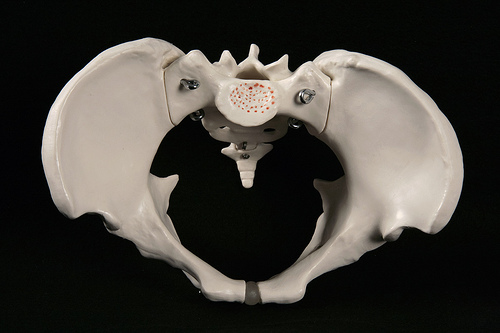
Pelvic Pain — An Overview
Pelvic pain is a very common symptom encountered in gynecological practice. Many women experience pelvic pain at some point in their lives. Pelvic pain can be divided into two main categories according to the duration of the pain. Pelvic pain lasting longer than 6 months is termed chronic, while pain lasting less than 6 months is termed acute pelvic pain. Clinical history and examination are extremely important in identifying a likely cause of the pelvic pain because many common gynecological causes of pelvic pain display characteristic pattern of symptoms. Common causes of pelvic pain include: Surgical causes – appendicitis, proctitis, colitis, bladder calculi, cystitis. Gynecological causes – ovulation pain, pelvic inflammatory disease, ovarian cysts (chocolate cyst), Polycystic Ovary Syndrome, torsion of ovaries, ectopic pregnancy, miscarriage, fibroids during pregnancy (red degeneration), endometriosis. Medical causes – urinary tract infections.
- Important notification about information and brand names used in this slideshow!
- Photo courtesy of NCSSM by Flickr : www.flickr.com/photos/ncssm/8660418447/
- gynecology by ten teachers
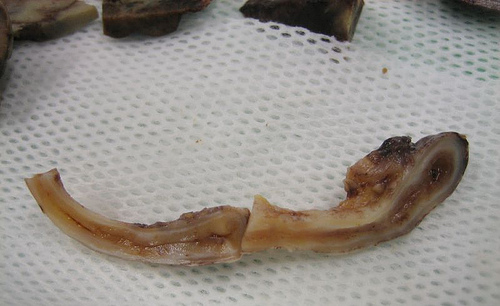
An Inflamed Appendix
An inflammation of the appendix usually causes a severe cramping pain in the right lower abdomen, as well as a fever. The position of the inflamed appendix is very important because when the appendix is pointed towards the pelvis (pelvic appendix) the pain is pelvic, and not the usual right-sided abdominal pain. A pelvic appendix may also cause diarrhea, burning pain while urinating and blood-stained urine. Patients will have difficulty standing up straight, because the inflamed appendix is touching the Psoas Major muscle. The lower abdomen will be painful to touch. Acute appendicitis without features of rupture can be treated with intra-venous antibiotics. A ruptured appendix will need emergency surgery followed by intra-venous antibiotics to treat the infection.
- Important notification about information and brand names used in this slideshow!
- Photo courtesy of Jimee, Jackie, Tom & Asha by Flickr : www.flickr.com/photos/wilderdom/228781557/
- An aid to clinical surgery by Williamson and Waxman

Painful Ovulation
Many women complain of mild pain in the lower abdomen halfway along their cycle. This is caused by ovulation. Although the ovary itself is insensitive to pain, the follicular fluid that is released with the ovum may irritate the inner lining of the abdominal cavity (the peritoneum) and cause a mild pain. Usually the ovary ruptures at an avascular site called the stigma to release the mature ovum. In some cases there might be a slight bleed. This blood may also irritate the peritoneum and cause pain. The pain associated with ovulation is termed ovulation pain, while the bleeding is called ovulation bleeding.
- Important notification about information and brand names used in this slideshow!
- Photo courtesy of rochelle hartman by Flickr : www.flickr.com/photos/tinfoilraccoon/6326642135/
- Gynecology by ten teachers

Premenstrual Syndrome (PMS)
Premenstrual Syndrome (PMS) is in essence a psychological manifestation of hormonal changes that occurs during the menstrual cycle. Women may or may not have actual physical symptoms. They may have sadness and irritability along with other features. It is important to note that the pattern of symptoms varies from one woman to another and one woman always experiences the same set of symptoms every cycle. Stress, high intake of caffeine, a family history of mood disorders such as depression, mania and increasing age are known risk factors of Premenstrual Syndrome. Supportive treatment is the mainstay while anti-depressants, diuretics and non-steroid anti-inflammatory drugs may also be used depending on the severity of symptoms.
- Important notification about information and brand names used in this slideshow!
- Photo courtesy of Anna Hirsch by Flickr : www.flickr.com/photos/antigone/462246906/
- Gynecology by ten teachers
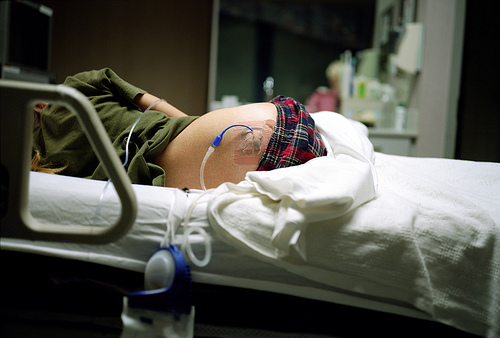
Pelvic Inflammatory Disease (PID)
Pelvic Inflammatory Disease is the inflammatory response to infections in the pelvic area that may involve the pelvic peritoneum, uterus, tubes, ovaries, and pelvic ligaments. The most common causative organisms are bacteria that usually colonize the gastrointestinal system and vagina. Escherichia coli, enterobacteria, and candida species are common culprits. Patients may experience lower abdominal pain sometimes increasing with menstruation, pain while urinating (dysuria), pain during sexual intercourse (dyspareunia) and vaginal discharge (whitish, watery, with or without itching). Patients may also have fever in severe cases. A full urine report, urine culture, and an ultrasound scan of the abdomen and pelvis may be done. Ultrasound scan may show a thin film of fluid in the pelvis. Antibiotics and pain killers are the mainstay of treatment.
- Important notification about information and brand names used in this slideshow!
- Photo courtesy of Alexandra Nicole Reifenrath by Flickr : www.flickr.com/photos/alexandranicolephotography/2947585215/
- Gynecology by ten teachers
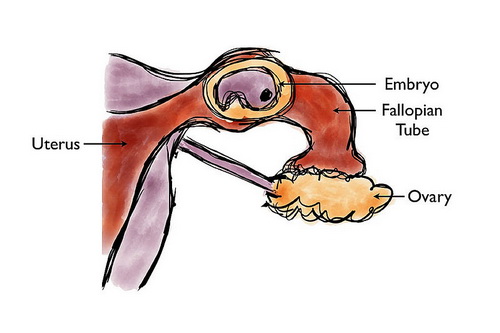
Ectopic Pregnancy
Ectopic pregnancy is the implantation of the morula (8-16 cell stage of the early human embryo) in an abnormal site — so outside of the normal uterine cavity. Common sites of ectopic pregnancy are the fallopian tubes, ovary, broad ligament, cervix and abdomen. The most common site is the isthmus of the fallopian tube. In an ectopic pregnancy, the outcome is almost always abortion. Patients will not menstruate (have a period of amenorrhea) followed by a severe lower abdominal pain and vaginal bleeding. Pregnancy tests will be positive. The abdomen will be very tender and a vaginal examination will elicit severe pain especially when the cervix is moved to a side (cervical excitation). The only treatment is surgery. Otherwise, there may be tubal rupture, severe bleeding and the patient’s life may be endangered.
- Important notification about information and brand names used in this slideshow!
- Photo courtesy of Takatakatakumi by Wikimedia Commons : commons.wikimedia.org/wiki/File:Ectopic_Pregnancy_Diagram.jpg
- Gynecology by ten teachers
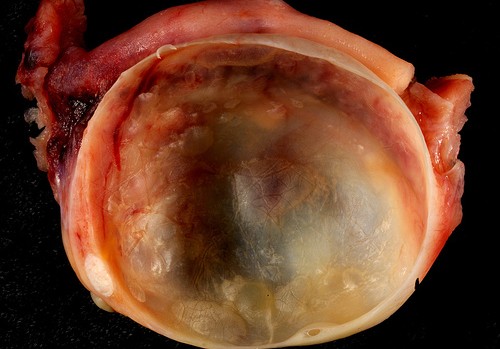
Ovarian Cysts
Most ovarian cysts are harmless (benign). Some might be cancerous (malignant). Benign cysts are unilocular (single cavity), thin walled and slowly enlarging. Malignant ones may be multilocular (multiple cavities), septated (thick walled) and may show rapid enlargement. In patients with endometriosis, bleeding into a small cavity may cause chocolate cysts of the ovary. An ultrasound scan may show the locular appearance, septea and blood flow. A thin film of free fluid may also be in the pelvis. If symptoms are mild the cyst can be monitored with regular scans. If it is rapidly enlarging, CA-125 (a blood test) is high, the patient is symptomatic, and is not planning on getting pregnant (completed the family) surgery can be offered.
- Important notification about information and brand names used in this slideshow!
- Photo courtesy of Ed Uthman by Flickr : www.flickr.com/photos/euthman/189396791/
- Gynecology by ten teachers

Uterine Fibroids
Uterine fibroids are almost always benign, and they do not usually cause pain. The only time fibroids may produce pain is during pregnancy. Fibroids are estrogen sensitive. In pregnancy estrogen levels are high and the fibroid enlarges and obtains a richer blood supply (red degeneration). Fibroids may be found inside the uterine wall, and attached to the broad ligament. Fibroids may also appear just under the inner uterine lining (submucosal), within the wall (intramural) and just under the outer lining of uterus (subserosal). Fibroids may have a stem (pedunculated). If the fibroid is large, the patient is symptomatic (heavy periods, irregular periods), the fibroid is causing complications (anemia due to heavy bleeding, disruption of lifestyle), and the patient has a completed family, surgery may be offered. Myomectomy is the removal of a fibroid only with its capsule while hysterectomy removes the uterus completely.
- Important notification about information and brand names used in this slideshow!
- Photo courtesy of Rádiológ by Wikimedia Commons : commons.wikimedia.org/wiki/File:Uterine_fibroid_CT.JPG
- Gynecology by ten teachers
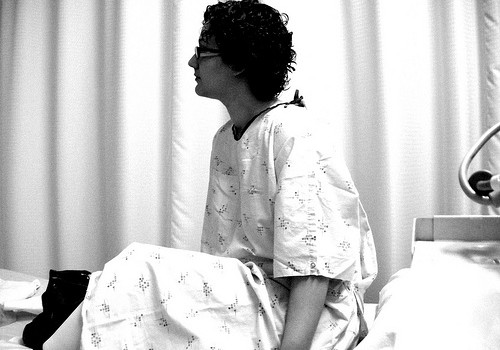
Endometriosis
Endometriosis is the presence of endometrial tissue in sites other than the normal uterine cavity under the control of the hypothalamo-putuitary-ovarian axis. If endometrial tissue is present within the uterine muscle it is known as adenomyosis. If present in ovaries and causes a cyst with altered blood inside it, it is called a chocolate cyst. Patients may have irregular periods, heavy menstrual bleeding, pain during menstruation usually starting before the onset and prolonged bleeding. Oral contraceptive pills, norethisterone, danazole and lupride may be used to control bleeding. Pain killers may be used as needed. Oral iron replacement may be needed if the patient is anemic due to bleeding. Laparoscopic diathermization (burning off) of endometriotic deposits, removal of ovaries (oophorectomy) may be offered according to the clinical status.
- Important notification about information and brand names used in this slideshow!
- Photo courtesy of Fuschia Foot by Flickr : www.flickr.com/photos/fuschia_foot/3448624487/
- Gynecology by ten teachers
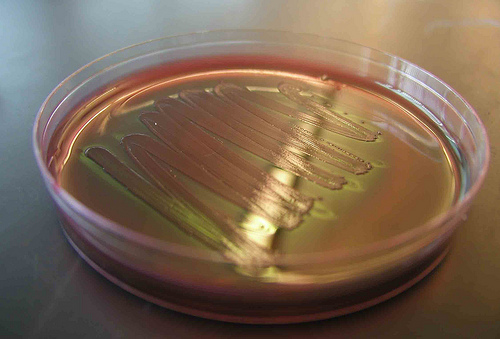
Urinary Tract Infection
Infection of the bladder (cystitis), urethra (urethritis) and kidneys (pyelonephritis) may cause a lower abdominal and pelvic pain. It is more common in sexually active females of reproductive age. The most common cause is E. coli. Other bacteria that normally colonize the gastrointestinal tract may also cause a UTI. Patients may have lower abdominal pain, burning pain while urinating, frequent urination, bloodstained urine and cloudy urine. Urine analysis, urine culture and antibiotic sensitivity may be done. Antibiotics, pain killers and good fluid intake are used for treating a UTI. Managing UTIs in children is much more challenging because congenital anomalies may be the cause of the UTI.
- Important notification about information and brand names used in this slideshow!
- Photo courtesy of Anthony D'Onofrio by Flickr : www.flickr.com/photos/adonofrio/6269446102/
- Clinical medicine by Kumar and Clark




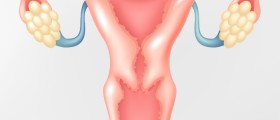













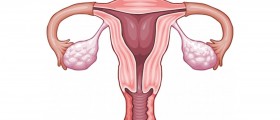








Your thoughts on this
Loading...